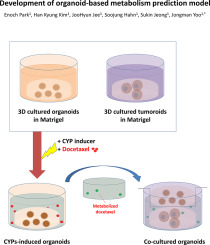当前位置:
X-MOL 学术
›
Toxicol. Appl. Pharmacol.
›
论文详情
Our official English website, www.x-mol.net, welcomes your feedback! (Note: you will need to create a separate account there.)
Development of organoid-based drug metabolism model.
Toxicology and Applied Pharmacology ( IF 3.8 ) Pub Date : 2019-10-31 , DOI: 10.1016/j.taap.2019.114790 Enoch Park 1 , Han Kyung Kim 1 , JooHyun Jee 1 , Soojung Hahn 1 , Sukin Jeong 1 , Jongman Yoo 1
Toxicology and Applied Pharmacology ( IF 3.8 ) Pub Date : 2019-10-31 , DOI: 10.1016/j.taap.2019.114790 Enoch Park 1 , Han Kyung Kim 1 , JooHyun Jee 1 , Soojung Hahn 1 , Sukin Jeong 1 , Jongman Yoo 1
Affiliation

|
Cytochrome P450 (CYP) gene superfamily catalyzes oxidative metabolism of a wide variety of drugs, carcinogens, and endogenous biomolecules in the liver and intestinal organs. In vitro assay platforms such as primary hepatocyte and immortalized liver-derived cell lines have been developed to evaluate drug effects. However, several limitations have been suggested regarding discrepancies between in vitro and in vivo assays. In this study, we aimed to investigate drug metabolism and toxicity based on mouse small intestinal and liver organoids derived from resident stem cells. At first, expressions and activities of CYP subfamilies (CYPs) in intestinal and liver organoids were investigated. Organoids treated with three CYPs-inducers dexamethasone (Dex), β-naphthoflavone (BNF), and 1,4-bis-2-(3, 5-dichloropyridyloxy)-benzene (TCPOBOP) were evaluated for CYPs activities. The CYPs-induced intestinal and liver organoids were confirmed to digest more docetaxel, as colon cancer cell-line survived more in CYPs-induced organoid's medium than in non-induced organoid's medium. Then, the activity of docetaxel in a co-culture platform of mouse liver organoids and human pancreatic tumoroids was measured. We obtained significant statistical values on CYPs-induced metabolic activities: cell survival rates of pancreatic tumoroids co-cultured with docetaxel-treated undifferentiated, differentiated, and CYPs-induced differentiated organoids were 66.05 ± 2.14%, 89.20 ± 2.67%, and 101.90 ± 0.94%, respectively. To sum up, gene expression modification and drug metabolism evaluation were able to be done with organoids as done with tissues. In vivo-like in vitro investigation on drug toxicity may potentially be done with organoids as a stepping bridge to the clinical trial.
中文翻译:

建立基于类器官的药物代谢模型。
细胞色素P450(CYP)基因超家族催化肝脏和肠道器官中多种药物,致癌物和内源性生物分子的氧化代谢。已经开发了体外测定平台,例如原代肝细胞和永生化肝来源的细胞系来评估药物的作用。然而,关于体外和体内测定之间的差异,已经提出了一些限制。在这项研究中,我们旨在研究基于小鼠小肠和常驻干细胞的肝类器官的药物代谢和毒性。首先,研究了CYP亚家族(CYPs)在肠道和肝脏类器官中的表达和活性。用三种CYPs诱导剂地塞米松(Dex),β-萘黄酮(BNF)和1,4-bis-2-(3,评估了5-二氯吡啶氧基)-苯(TCPOBOP)的CYP活性。由于结肠癌细胞系在CYPs诱导的类器官的培养基中比未诱导的类器官的培养基中存活得更多,因此证实CYPs诱导的肠和肝类器官可以消化更多的紫杉萜。然后,测量多西紫杉醇在小鼠肝类器官和人胰腺类肿瘤的共培养平台中的活性。我们获得了有关CYP诱导的代谢活性的重要统计值:与多西他赛治疗的未分化,分化和CYP诱导的分化类器官共培养的胰腺类肿瘤的细胞存活率分别为66.05±2.14%,89.20±2.67%和101.90±0.94。 %, 分别。综上所述,与组织一样,类器官可以完成基因表达修饰和药物代谢评估。
更新日期:2019-11-01
中文翻译:

建立基于类器官的药物代谢模型。
细胞色素P450(CYP)基因超家族催化肝脏和肠道器官中多种药物,致癌物和内源性生物分子的氧化代谢。已经开发了体外测定平台,例如原代肝细胞和永生化肝来源的细胞系来评估药物的作用。然而,关于体外和体内测定之间的差异,已经提出了一些限制。在这项研究中,我们旨在研究基于小鼠小肠和常驻干细胞的肝类器官的药物代谢和毒性。首先,研究了CYP亚家族(CYPs)在肠道和肝脏类器官中的表达和活性。用三种CYPs诱导剂地塞米松(Dex),β-萘黄酮(BNF)和1,4-bis-2-(3,评估了5-二氯吡啶氧基)-苯(TCPOBOP)的CYP活性。由于结肠癌细胞系在CYPs诱导的类器官的培养基中比未诱导的类器官的培养基中存活得更多,因此证实CYPs诱导的肠和肝类器官可以消化更多的紫杉萜。然后,测量多西紫杉醇在小鼠肝类器官和人胰腺类肿瘤的共培养平台中的活性。我们获得了有关CYP诱导的代谢活性的重要统计值:与多西他赛治疗的未分化,分化和CYP诱导的分化类器官共培养的胰腺类肿瘤的细胞存活率分别为66.05±2.14%,89.20±2.67%和101.90±0.94。 %, 分别。综上所述,与组织一样,类器官可以完成基因表达修饰和药物代谢评估。


























 京公网安备 11010802027423号
京公网安备 11010802027423号